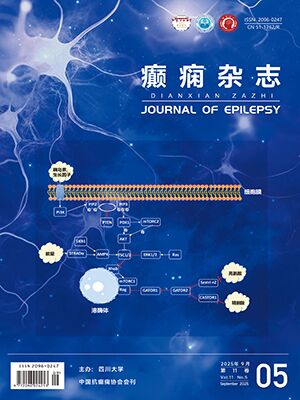| 1. |
张月华. 热敏感相关的癫痫临床和分子遗传学研究. 中国实用儿科杂志, 2015, 30(7): 487-491.
|
| 2. |
徐瑜欣, 钟建民. 热敏感相关癫痫的早期识别与诊断. 中国当代儿科杂志, 2021, 23(7): 749-754.
|
| 3. |
冼慧文, 高平明. 儿童热敏感相关癫痫25例临床特征及分子遗传学分析. 中国临床医生杂志, 2022, 50(4): 487-492.
|
| 4. |
黄广兰. 192例遗传性癫痫患儿的临床表型与基因型分析. 广西医科大学, 硕士学位论文, 2022.
|
| 5. |
中华医学会儿科学分会神经学组. 热性惊厥诊断治疗与管理专家共识(2017实用版). 中华实用儿科临床杂志, 2017, 32(18): 1379-1382.
|
| 6. |
Scheffer I E, Berkovic S, Capovilla G, et al. ILAE classification of the epilepsies: Position paper of the ILAE Commission for Classification and Terminology. Epilepsia, 2017, 58(4): 512-521.
|
| 7. |
Jafarpour S, Hirsch L J, Gaínza-Lein M, et al. Seizure cluster: definition, prevalence, consequences, and management. Seizure, 2019, 68: 9-15.
|
| 8. |
Trinka E, Cock H, Hesdorffer D, et al. A definition and classification of status epilepticus--Report of the ILAE Task Force on Classification of Status Epilepticus. Epilepsia, 2015, 56(10): 1515-1523.
|
| 9. |
Richards S, Aziz N, Bale S, et al. Standards and guidelines for the interpretation of sequence variants: a joint consensus recommendation of the American College of Medical Genetics and Genomics and the Association for Molecular Pathology. Genet Med, 2015, 17(5): 405-424.
|
| 10. |
国家儿童医学中心, 首都医科大学附属北京儿童医院保健中心, 北京市儿科专业质量控制和改进中心, 等. 中国全面发育迟缓诊断指南. 中华实用儿科临床杂志, 2024, 39(7): 481-489.
|
| 11. |
方志旭. SCN1A基因相关癫痫研究进展. 临床儿科杂志, 2021, 39(3): 231-236.
|
| 12. |
Cetica V, Chiari S, Mei D, et al. Clinical and genetic factors predicting Dravet syndrome in infants with SCN1A mutations. Neurology, 2017, 88(11): 1037-1044.
|
| 13. |
蒋永莉, 江文. GABRG2基因突变与癫痫相关性研究进展. 中华神经科杂志, 2020, 53(10): 824-829.
|
| 14. |
杨莹, 张月华, 陈娇阳, 等. GABRB2基因变异相关癫痫的临床特点. 中华儿科杂志, 2019, 57(7): 532-537.
|
| 15. |
李信晓, 郭胜楠, 蒋战胜, 等. GABRG2基因突变致遗传性癫痫伴热性惊厥附加症的分子遗传学研究进展. 癫痫杂志, 2023, 9(3): 235-242.
|
| 16. |
Hernandez CC, Tian X, Hu N, et al. Dravet syndrome-associated mutations in GABRA1, GABRB2 and GABRG2 define the genetic landscape of defects of GABA(A) receptors. Brain Commun, 2021, 3(2): fcab033.
|
| 17. |
Kowkabi S, Yavarian M, Kaboodkhani R, et al. PCDH19-clustering epilepsy, pathophysiology and clinical significance. Epilepsy Behav, 2024, 154: 109730.
|
| 18. |
陈奕, 张月华. PCDH19基因相关癫痫治疗和预后研究进展. 中国实用儿科杂志, 2022, 37(7): 541-545.
|
| 19. |
Cousin MA, Creighton BA, Breau KA, et al. Pathogenic SPTBN1 variants cause an autosomal dominant neurodevelopmental syndrome. Nat Genet, 2021, 53(7): 1006-1021.
|
| 20. |
Ruzzo EK, Capo-Chichi JM, Ben-Zeev B, et al. Deficiency of asparagine synthetase causes congenital microcephaly and a progressive form of encephalopathy. Neuron, 2013, 80(2): 429-441.
|
| 21. |
宋振凤, 易致, 李菲, 等. ASNS基因变异致天冬酰胺合成酶缺乏症一家系分析并文献复习. 中华实用儿科临床杂志, 2021, 36(9): 690-693.
|
| 22. |
宋盼盼, 张晓莉, 李小丽, 等. 天冬酰胺合成酶缺乏症6例临床及遗传学特点. 中华儿科杂志, 2024, 62(4): 368-373.
|
| 23. |
刘亚韦, 张颖, 曲政海. Wolf-Hirschhorn综合征一例及文献分析. 中国医师进修杂志, 2018, 41(4): 356-358.
|
| 24. |
Friebe-Hoffmann U, Reister F, Gaspar H, et al. The Wolf-Hirschhorn Syndrome. Z Geburtshilfe Neonatol, 2016, 220(5): 195-199.
|
| 25. |
Paprocka J, Kaminiów K, Yetkin O, et al. Clinical and epilepsy characteristics in Wolf-Hirschhorn syndrome (4p-): a review. Seizure, 2024, 116: 14-23.
|
| 26. |
蒋萍, 张桐, 汤继宏, 等. 新生突变的16p11. 2微缺失综合征(附1例报告及文献复习). 中国临床神经科学, 2021, 29(3): 303-309.
|
| 27. |
Chung WK, Roberts TP, Sherr EH, et al. 16p11. 2 deletion syndrome. Curr Opin Genet Dev, 2021, 68: 49-56.
|
| 28. |
叶园珍, 麦嘉卉, 胡湛棋, 等. 以癫(癎)为主要表型的16p11. 2微缺失综合征11例病例系列报告. 中国循证儿科杂志, 2022, 17(2): 144-148.
|




